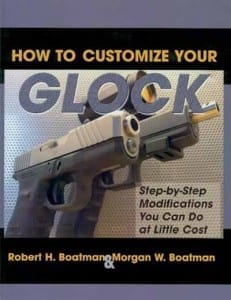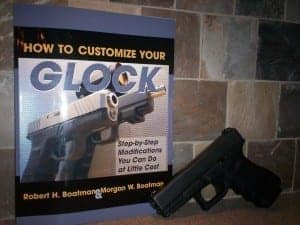How to Customize Your Glock
(Step-by-Step Modifications You Can Do at Little Cost)
I must admit I was a bit intrigued when asked to review a book dedicated solely to the customization and enhancement of a handgun whose one word marketing tag line is simply: “Perfection”. That might sound like a tall order indeed. However, my review of the book How to Customize Your Glock (Step-by-Step Modifications You Can Do at Little Cost) by the father and son team of Robert and Morgan Boatman proved to be a rather interesting undertaking.
The authors limit the book’s scope to those operator level modifications using mass produced, drop-in parts, which serve to enhance overall reliability of the already box-stock reliable Glock designs. In their narrative they discuss in detail the possible downside risks of wantonly customizing a Glock, particularly if it is primarily to be used as a carry piece. Prudently, the authors avoid controversy by making no claims as to which specific aftermarket or factory parts are most superior. Rather, they speak to the appropriateness of changing out a part, in general, with the goal of improving reliability and/or accuracy. This being said, for those wishing to proceed to the next level in Glock customization they reference contact information for a particular nationally known gunsmith specializing in the Glock family of pistols.
As for me personally, I also take a “less is best” approach when it comes to any modifications which will not enhance a firearm’s reliability or smooth its trigger/action. I found the Boatman team’s writings on the subject of Glock customization to be refreshing, informative and right in line with my own views. The firearms in my modest collection are what most would characterize as comprising a “working battery”. No safe queens or ultra-specialized pieces to be found in the lot. By and large, they’re just “rack grade” specimens that are either box-stock, or lightly tweaked by way of having actions smoothed, guide rods installed or combat-type luminescent sights installed. Additionally, like most shooters I’m known to also change out handgun grips on occasion to aid in obtaining a more solid and repeatable grip.
The Boatman team’s book, which is a quick, concise read, would be an excellent choice for virtually any Glock owner. For those who either have or have not attended a Glock armorer’s course, but who nonetheless need a manual containing detailed information and excellent pictures showing how to field strip, detail strip, lubricate and change out “over the counter” parts, this book would be a good choice. Speaking as a Glock 23 owner who has other publications regarding the design, development and operation of Glocks, I would highly recommend starting with this book, or adding a copy to your library, based on its specific focus and easy-to-understand format. Those who would particularly benefit from it would include anyone carrying a Glock for duty, or as a CCW permit holder, or who competes with a Glock in the action-shooting sports such as IDPA or USPSA.

The book is broken down into four main sections, with each successive section detailing categories of modifications requiring modestly increasing disassembly/reassembly skills. Fear not however! Practically speaking, you don’t need either three hands or any other superhuman aptitude to modify your Glock with drop-in parts. Likewise, you won’t need to take out a second mortgage on your home in order to buy the necessary tools. It is much easier than you think if you take a cue from the carpenter’s sage advice of “measuring twice and cutting once”. In this case, read the book cover to cover and digest its information. Then, re-read the applicable section(s) you’re interested in, ensuring you thoroughly understand the process BEFORE you take apart your gun. The Boatman’s easy writing style puts otherwise dry, technical prose into easily understandable layman’s terms.
The first section deals with modifications which can be made with no disassembly of the pistol (after properly checking to ensure that the piece has both an empty chamber and an empty magazine well). The second section deals with modifications which require a basic field strip of the pistol, such as when cleaning. The third section deals with modifications which require detail stripping the slide. The fourth section discusses those modifications which would require detail stripping the frame. The pages are chocked full of excellent pictures of the disassembly/reassembly procedures along with a good overview of the simple tools needed to break the average Glock down into it’s 30 or so component pieces. There is also a very good section regarding the disassembly of Glock magazines for both cleaning and replacement of any sub-component parts.
The subject matter of this book particularly resonated with me as several years ago I had modified a couple of components in my Glock model 23 so as to increase its reliability and sights. I replaced the OEM coiled steel factory trigger spring with one of Glock’s polymer and spring steel New York 1 (NY-1) trigger springs so as to both markedly strengthen what is sometimes regarded as a weak link in the basic design of the Glock firing mechanism and to provide a smoother, albeit slightly heavier, trigger stroke. To offset the heavier trigger pull it produced I replaced the factory 5.5 lb. disconnector with an aftermarket 3.5 lb. disconnector. This combination, while increasing trigger spring longevity over the basic trigger spring set up also provided a smoother DA-only trigger stroke and “snappier” trigger reset after the shot breaks. The Boatman’s speak to this type of modification specifically in their work and it is well worth reading. I also replaced the factory plastic recoil spring guide rod with a one-piece metal rod to eliminate the possibility of the recoil spring kinking during the slide cycling sequence and lastly I switched out the OEM plastic non-luminescent sights with a set of Glock’s fixed, metal luminescent ones.
My experience is that with these basic modifications I have, to some degree, improved the integrity and longevity of the firing mechanism, while smoothing up the trigger stroke and getting faster trigger resets. Additionally, the installation of the one-piece guide rod with the factory spring held captive aids in smoothing things up a bit by way of the slide cycling. Lastly, the installation of Glock’s factory metal, fixed, night sights rounded out what I felt was needed to make the pistol appropriate for defensive use night or day.
With a mixture of several thousand rounds of factory FMJ and JHP down the tube to date, I’ve had no failures to feed, fire and eject with the pistol, and I like the smoother trigger stroke, faster trigger reset as well as the sight picture provided by the night sights. I feel as though my experience during and after the fact of modifying my G23 reinforces the central tenets of the Boatman’s excellent book in that I can categorically say that the basic reliability enhancements they discuss work well and complement the Glock’s basic robust design.
By way of an objective book review the only points that I could make in possibly improving the book in subsequent editions would be for it to be spiral-bound so as to lay flat when you’ve got it out and you’re working on your gun. I think most how-to books of this type, or reloading manuals for that matter, should be spiral bound for ease of use when working at the bench or table. This recommendation is more directed to the publisher, and is just my two cents… Additionally, and at the risk of sounding like some Ralph Nader-ish OSHA type, I would include verbiage recommending that users should wear safety glasses when disassembling a spring loaded assembly on any gun. Having first-hand experience with disassembling an M14 bolt by hand, I have immense respect for the energy contained in that bolt’s compressed ejector assembly. Working with springs and small parts simply requires one to wear glasses for safety’s sake. This is a minor criticism for sure, as I would venture that most responsible firearm owners implicitly understand the need for, and do take, proper eyewear precautions when both shooting, working on their guns or reloading.
All in all, this book would hands-down be a worthwhile addition to any Glock owner’s or enthusiast’s collection as it is a well thought out and well written manual on enhancing one of the most influential and seminal handgun designs of the last 25 years.
For additional information regarding the book How to Customize Your Glock (Step-by-Step Modifications You Can Do at Little Cost) by Robert H. Boatman & Morgan W. Boatman please go to Morgan Boatman’s website: www.customizeyourglock.com. Additional information, reader testimonials, and photos of the book can be found there. Biographical information on the Boatman team authors can also be found, in addition to information on their other firearm-related books. You can purchase a copy of the book in this review directly from the website for $19.95 + shipping. Alternately, you can also purchase a copy of the book directly from the publisher, Paladin Press of Boulder Colorado. Paladin Press can be contacted via their website at www.paladin-press.com, or by calling them at (800)392-2400 to place a credit card order by phone.

Reviewed By: B.T. Davis
